If you’ve ever been captivated by the sleek elegance of a Whippet, you’re not alone.
These amazing dogs, known for their undying love and expressive eyes, come in a stunning array of coat colors that paint a picture of beauty and grace.
In this article, we’ll delve into the depths of the most intriguing Whippet colors: black, blue, blue brindle, blue fawn, and many more!
18 Standard Whippet Colors
1. Black
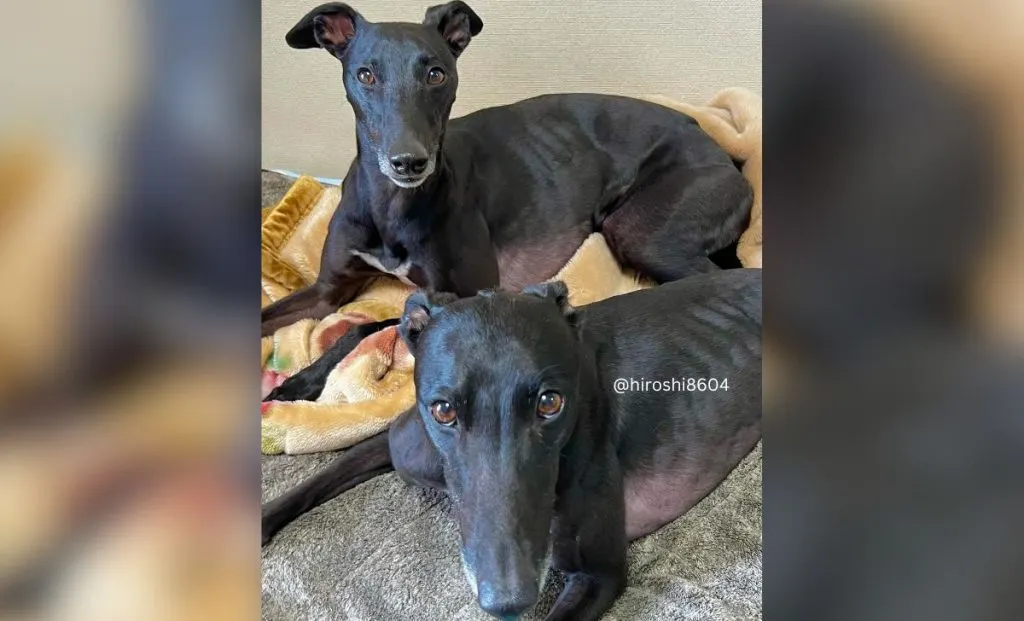
Think of the deepest night sky, that’s the Whippet in black color. It’s sleek and elegant, just like the rest of the breed.
Although a standard solid color, it is not always jet black. These dogs can have subtle sheen or slight variations, such as a white marking across their chest and neck.
Besides Whippets, other breeds like Labradors and Doberman Pinschers also boast coats of deep black.
2. Blue
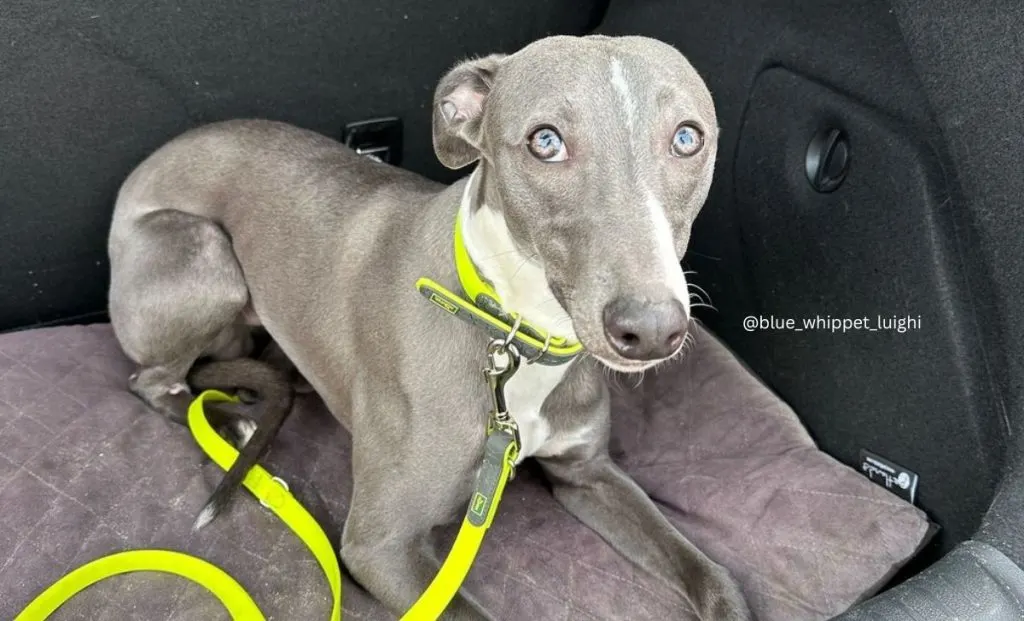
The blue color is a dilute version of black, caused by a specific genetic trait that affects the pigment in the fur. It results in a steel-gray appearance. This shade is one of the dilute colors in dogs, which also includes shades like lilac.
While blue may not be as prevalent in other breeds, its dilute black pigment gives Whippets a bluish-gray hue that’s simply mesmerizing.
A blue Whippet puppy may often exhibit a blue mask.
This unique shade sets them apart from the crowd, with only a handful of other breeds like Great Danes and Kerry Blue Terriers sporting similar tones.
3. Blue Brindle
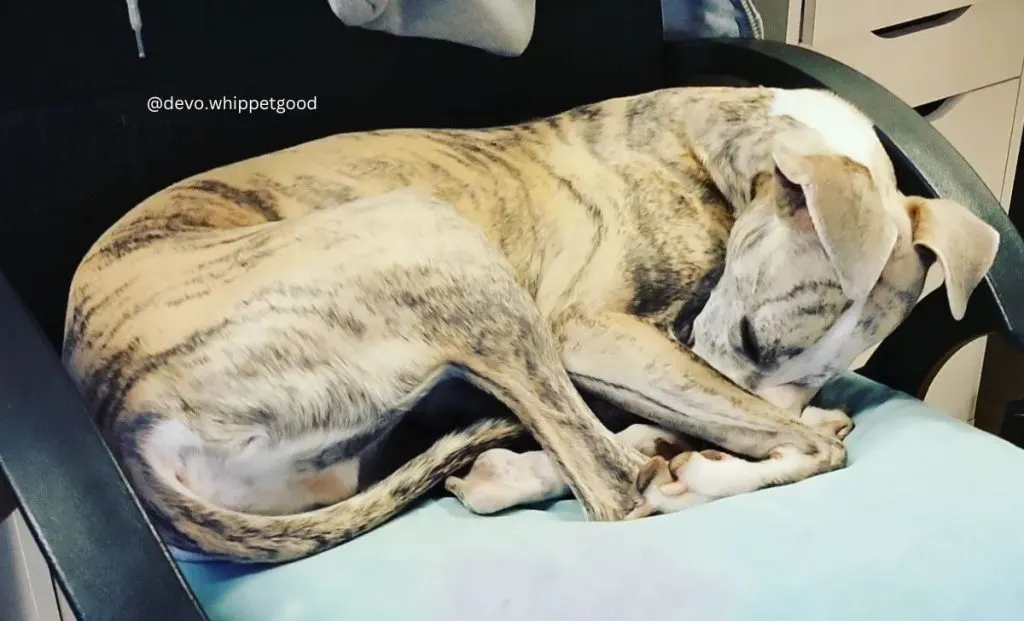
Brindle is not a color, but a pattern in Whippets where dark stripes appear over a lighter base, creating a tiger-stripe effect. It is commonly seen in Greyhounds, Boxers, and Cane Corso dogs.
Now, in blue brindles, these stripes are a muted blue over a fawn or gray base.
Blue brindle Whippets are striking due to their unique intermingling of colors. Like little tigers!
This pattern makes them very beautiful and is an excellent choice for those who appreciate complexity in canine coat patterns.
4. Fawn
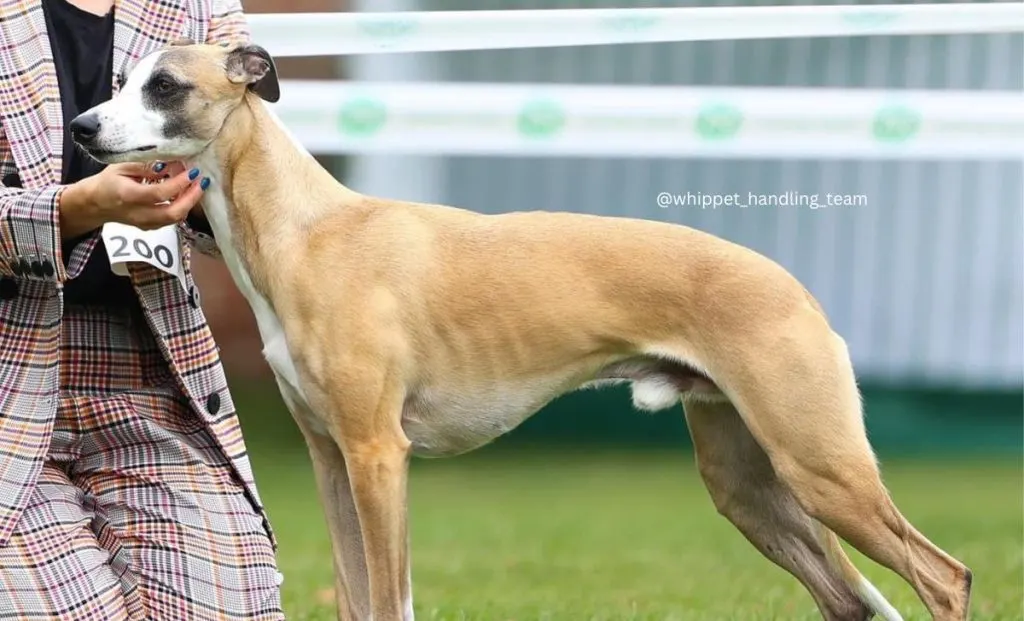
Fawn color is one of the common coat colors of Whippets and is highly sought after for its natural and earthy hue, which enhances the dog’s fine features and expressive eyes.
Fawn is an interesting color that refers to a light, deer-like color. It ranges from pale tan to deeper hues. It’s a common color in many dog breeds, especially crossbreeds like many Anatolian Shepherd mixes.
Fawn Whippets can range from light sandy shades to rich buffs and are often accompanied by white patches, especially on the chest and feet.
5. Blue Fawn
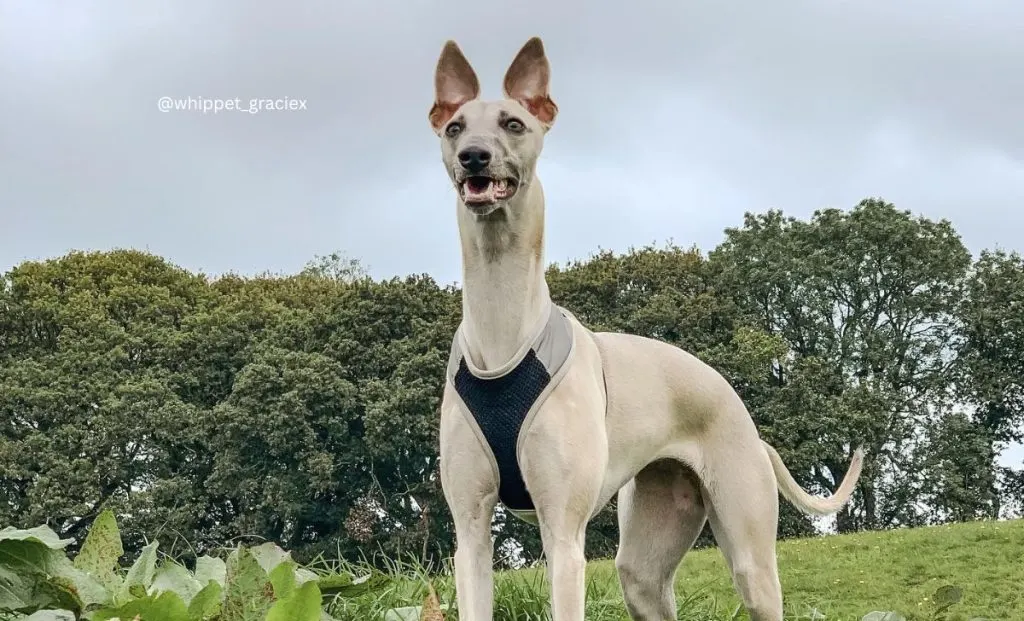
Now, in blue fawn Whippets, the fawn color is tinged with a blue sheen, thanks to the dilution gene.
This results in a coat that seems to shift in different lights, from a soft cream to a shimmering blue.
While blue fawn color is distinctive in Whippets, other breeds like the French Bulldog can also exhibit this exact color, though it is far less common.
6. Fawn Brindle

Fawn color may also present in patterns, such as the striking fawn brindle, where dark stripes overlay a fawn base.
Fawn brindle is a result of a genetic interplay where the brindle pattern expresses itself on a fawn base.
The fawn brindle color in Whippets is a remarkable pattern where dark stripes overlay a base of soft fawn, giving the appearance of a warm, sunlit forest floor.
While it may look like a paint color, it is relatively common in the breed. I think it presents a perfect example of the harmonious blend of colors that can occur naturally.
7. Red

Red Whippets can range from a soft cream to a vibrant, deep rust color, reflective of their undying love and warmth. The intensity of this red color can vary significantly, influenced by the MC1R gene.
This gene’s variations, especially the ‘e’ allele, are important in producing the diverse red color ranges seen across different dog breeds (1).
Besides Whippets, other dog breeds known for sporting red coats include Irish Setters (known for their rich mahogany), and Vizslas, (known for their distinctive golden rust).
The commonality in these dog breeds is the expression of pheomelanin, which provides the pigment for red hues.
8. White
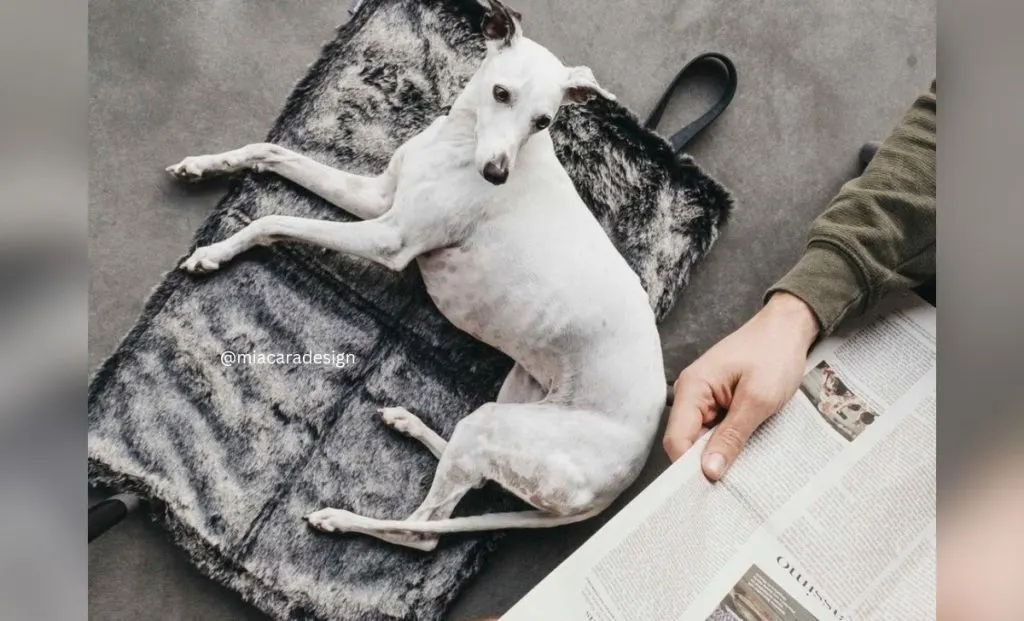
White Whippets are often described as white as snow! They exhibit coats that are pure, unmarked, and strikingly beautiful. This color is not the rarest but carries its own set of challenges and beauties.
While visually stunning, white Whippets may require more grooming due to the visibility of dirt on their sleek coats. This may also necessitate an ideal environment that is dirt- and dust-free!
White dogs are generally healthy, but they can be prone to sunburn and may have a higher incidence of deafness (2).
It’s also important to differentiate between albinos and white-coated Whippets.
Albinism in dogs is characterized by a lack of pigment throughout the body, including the skin and eyes. Now, white-coated Whippet dogs have normal pigmentation in these areas.
9. White & Fawn
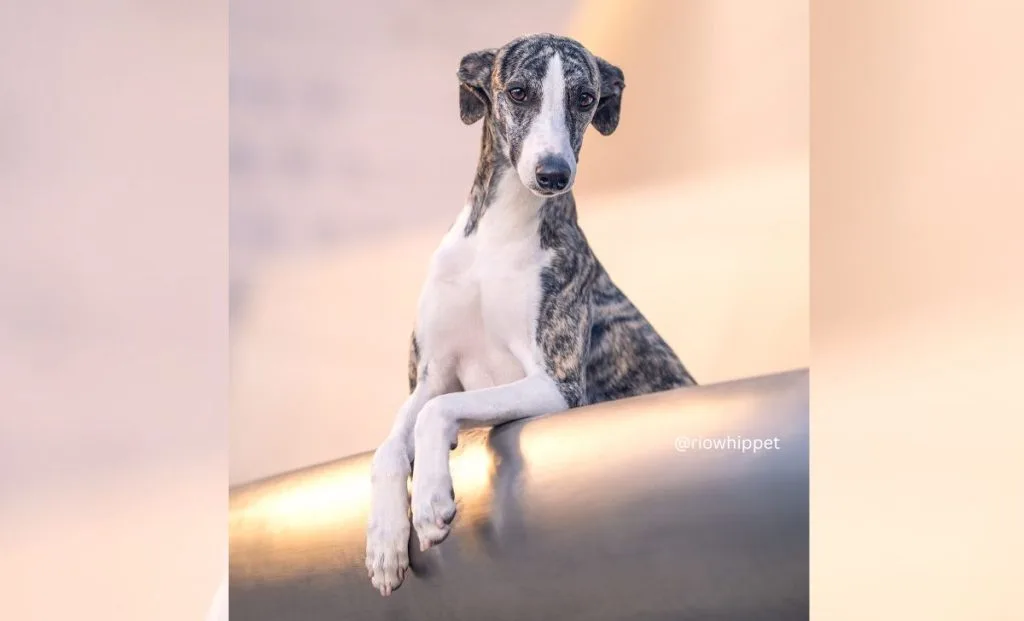
The white and fawn combination is one of the many AKC standard colors for Whippets on this list. And it is personally one of my favorites!
This mix of hues provides a soft cream base with fawn overlays, making it a common and beloved appearance among purebred Whippets.
This coat color is very much admired for its aesthetic balance. It offers a soft, yet expressive look that highlights the Whippet’s elegant contours and expressive eyes.
10. White & Red

Moving on to White and red Whippets. These pups typically exhibit a particolour pattern, where patches of vibrant red sit beautifully on a white base. We can often see this type of color in Poodles!
This coloration can remind one of a painted canvas. Well, a White and red Whippet’s coat usually has at least 50% white, with patches of red.
Their contrasted hues enhance their general appearance and make them a favorite for shows and companions. What do you think?
11. Red Brindle
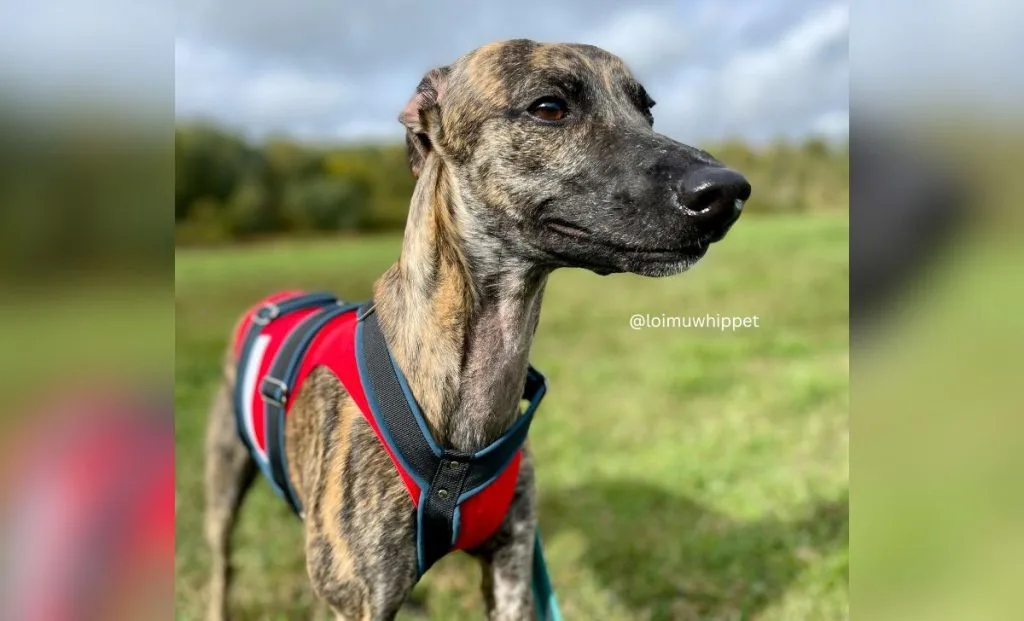
Red brindle Whippets exhibit a stunning range of dark red stripes on a lighter red or fawn background.
Research has shown that variations in the pheomelanin pigment are largely responsible for the different intensities of red seen in this pattern.
A study highlighted that five genetic variants explain a significant portion of the variation in coat color intensity among dog breeds, showing the complex genetics behind these beautiful patterns (3).
12. White & Blue Fawn
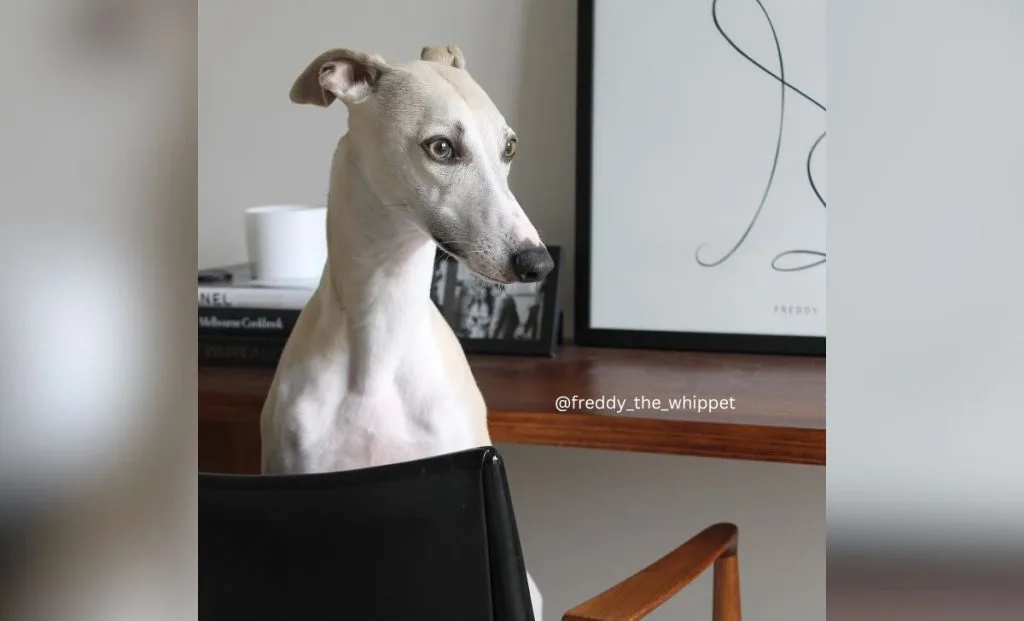
White and blue fawn Whippets often exhibit a wonderful interplay of colors that melds icy dilute tones with warm, earthy shades.
The blue fawn base is like a softened black giving way to a dusky blue, which is paired with clean white patches.
This coloration is particularly striking around the shoulder blades and hind legs, where the white often transitions seamlessly into the blue fawn.
In comparison, breeds like the Australian Shepherd may also exhibit similar blue fawn shades due to the merle gene, but the specific contrast with white is a standout feature more commonly observed in Whippets.
13. White & Black
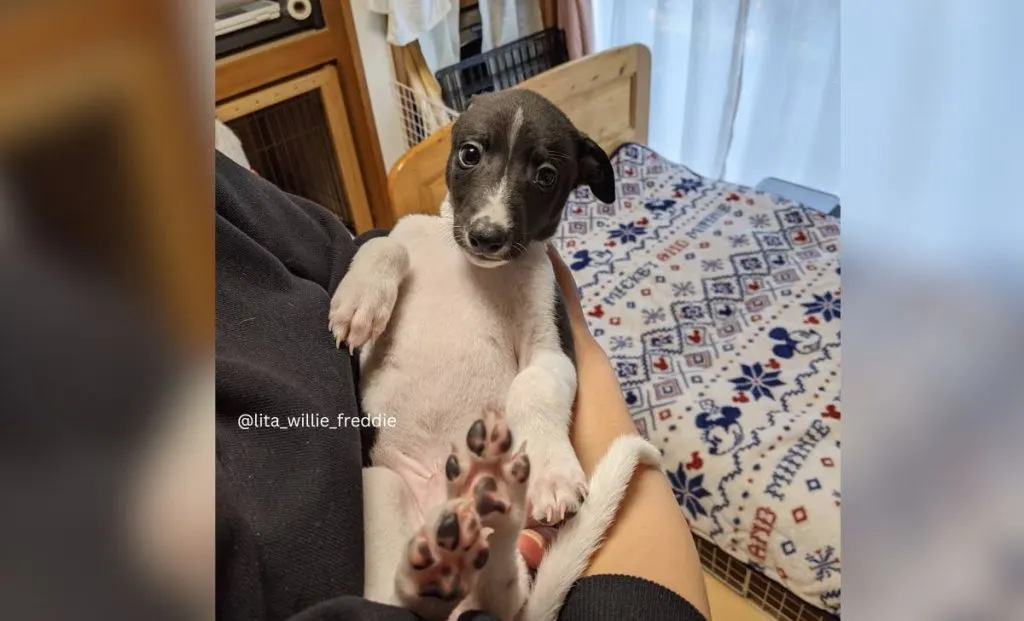
White and black Whippets are a classic example of elegance in canine form. Tuxedo dogs that sure standout in any setting.
Their coats feature sharp, clear demarcations between pure white and deep black. This color pattern adheres closely to the Whippet standard which shows a clean and dramatic look.
14. White & Blue

The white and blue Whippet sports a coat where blue colored sections (dilute colour of black pigment) are interspersed with snowy white patches.
Like their counterparts in other dilute breeds such as the Weimaraner, the blue in Whippets is a muted, grayish hue that softens the overall expression of the dog.
15. Cream
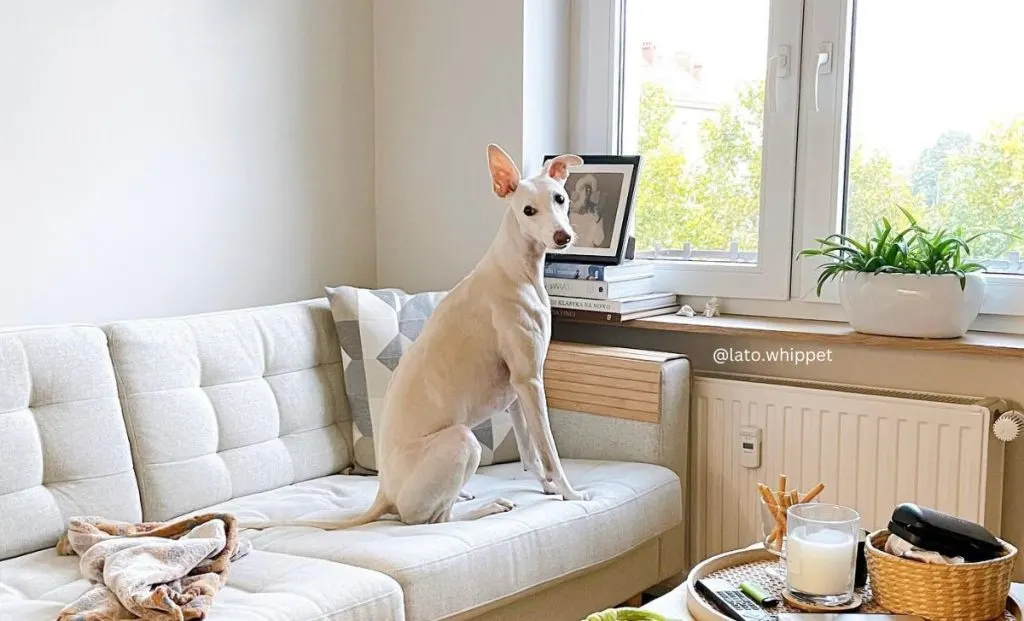
Cream Whippets come in a warm, uniform, solid color.
Its coat ranges from a soft cream to a richer, beige hue. This color is soft to the eye and gentle in its presentation. The Whippet’s short fur highlights the uniformity of the shade beautifully.
Interestingly, this color is often associated with a calm and pleasant demeanor in the dog.
This makes cream Whippets a favorite among pet parents for their understated elegance and the ease of matching them with various home environments.
16. White & Blue Brindle
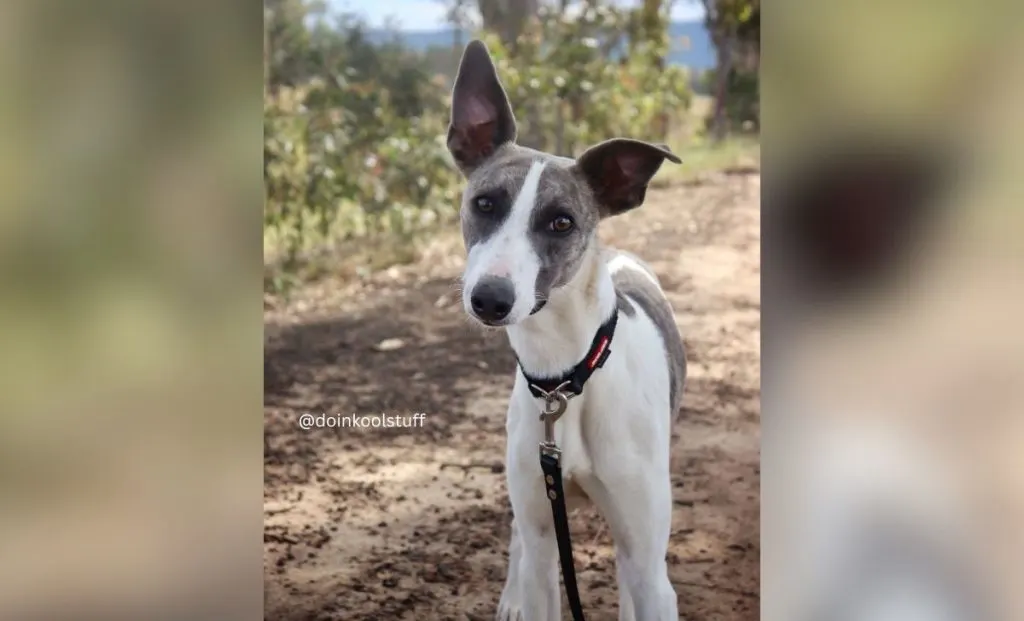
White and blue brindle Whippets are among the best Whippet colours for those who are looking for a unique pup that surely stands out in the crowd!
In this variation, striking blue brindle stripes (dilute black stripes that have turned to shades of blue) overlay a base coat of white. This pattern adds a dynamic quality to the dog’s coat, and it offers quite a visual spectacle.
Did you know that it is quite rare and highly sought after? Well, no wonder!
17. White & Red Brindle

The white and red brindle Whippet inherits red brindle stripes weaving through a pure white base.
This deep, vibrant red goes against a stark white base which puts this pup right in the spotlight. Such stunning visual contrast is not commonly seen in many other dog breeds.
Like many Whippets with unique coat patterns, those with white and red brindle may face common issues specific to their coloring. The white fur may be more susceptible to skin conditions and requires regular grooming to maintain its beauty.
Additionally, the potential for sun sensitivity in the lighter areas means that pet parents should use regular tips such as sunscreen for dogs during long periods outdoors.
18. White & Fawn Brindle

The last one of the standard Whippet colors is white and fawn brindle. This shade combines soft fawn stripes with a pure white background. The combination of colors enhances the sleek, streamlined physique of the Whippet.
The fawn stripes usually extend across the body in a delicate yet distinct pattern.
Don’t you think it makes these dogs not just pets but also works of art?
This color pattern is particularly praised for its aesthetic value and is considered one of the best Whippet colors for those looking for a dog with a standout appearance.
3 Common Coat Colors Of Whippets
These Whippet colors encircle a wide range of variations within the standard.
However, there are additional colors and patterns that may occur in Whippets, which are not included in the AKC standard but still often seen in the breed.
These include:
1. Sable
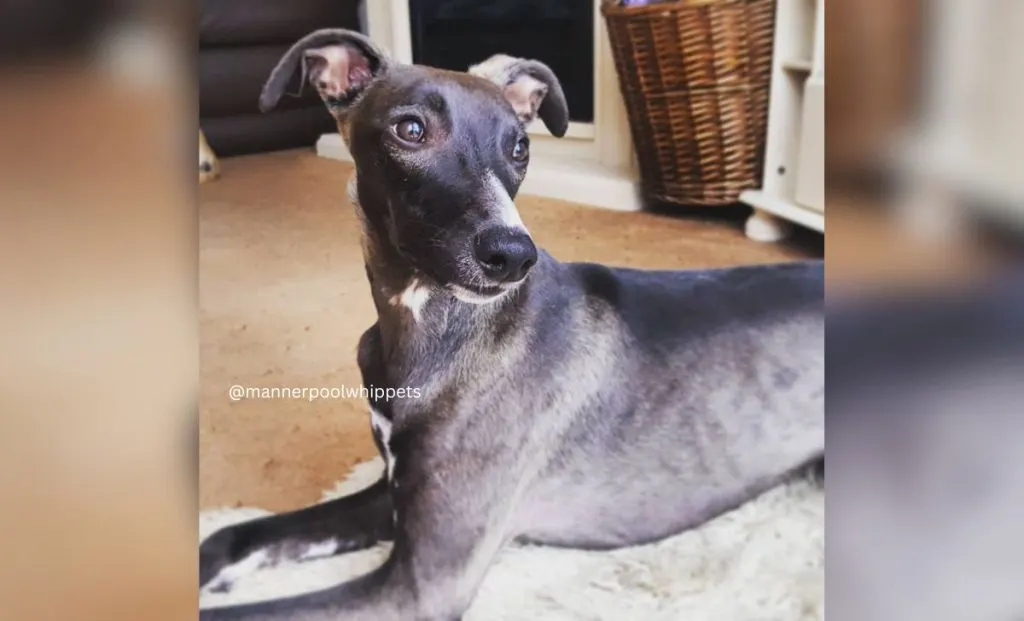
Sable Whippets exhibit a stunning coat color that combines a base of fawn with black-tipped hairs, creating a shaded or multi-toned effect. This unique coloration enhances the breed’s sleek lines and agile form.
Sable is not a standard color in Whippets, but it shows the breed’s potential for diverse and eye-catching appearances.
2. Black Brindle

Black brindle Whippets display a unique pattern of dark black stripes over a lighter undercoat, typically a shade of gray or silver.
This pawesome patterning adheres to the breed characteristics that favor lean muscle visibility and elegant movement. And the brindle stripes highlight the physical definition of this dog.
3. White & Sable

White and sable Whippets combine a white base coat with the intricate detailing of sable coloration. It often appears along the back, ears, and sometimes as markings on the face.
This color combination can create a truly beautiful appearance!
X Standard Markings Of Whippets
Standard markings on Whippets typically include a balanced distribution of color with possible white patches on the chest, paws, and tail tip.
1. White Markings

White markings in Whippets are charming and can vary from subtle accents to more pronounced patches.
These markings are typically found on the chest, paws, tip of the tail, and often as a white blaze or collar around the neck.
2. Black Mask
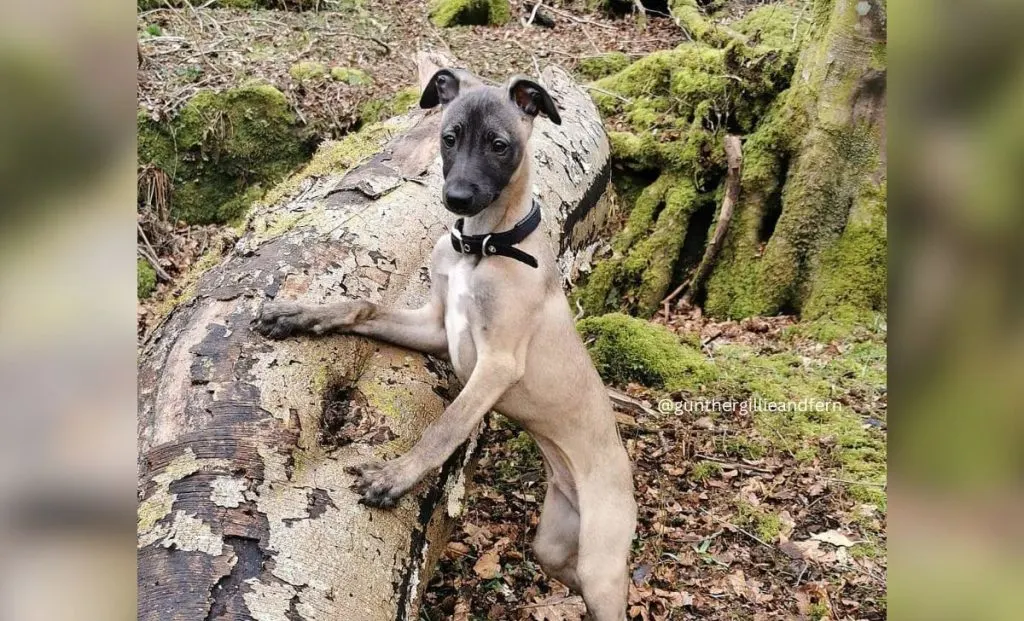
The black mask on a Whippet covers their muzzle and extends to the rest of the face and ears.
It truly emphasizes their adorable, expressive eyes and refined head structure.
3. Blue Mask
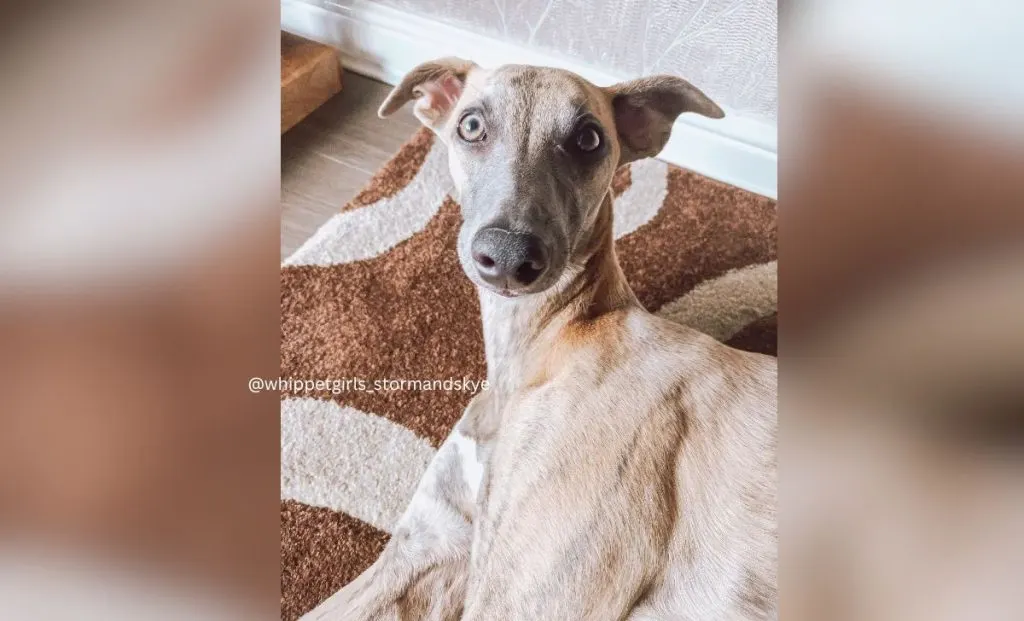
A blue mask on a Whippet gives a softer, lighter look when compared to the black mask.
Much like the black mask, the blue mask extends from the muzzle, across the face.
4. White Markings And Blue Mask
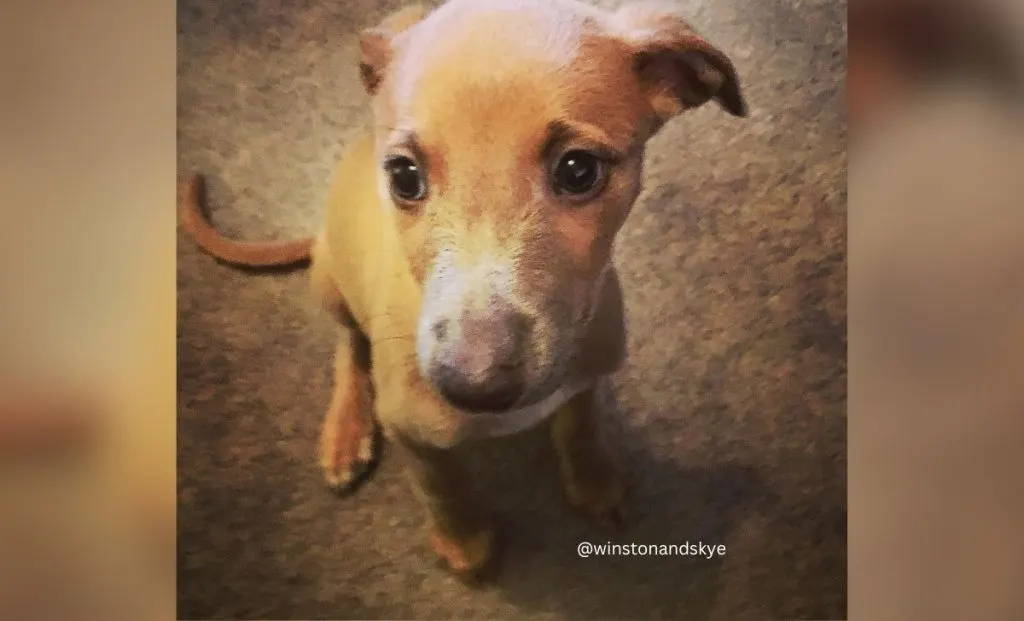
Combining white markings with a blue mask creates a harmonious blend of colors that is quite interesting to look at.
The blue mask covers the muzzle and sometimes extends around the eyes, and you can see parts of white on the base of their nose.
5. White Markings And Black Mask
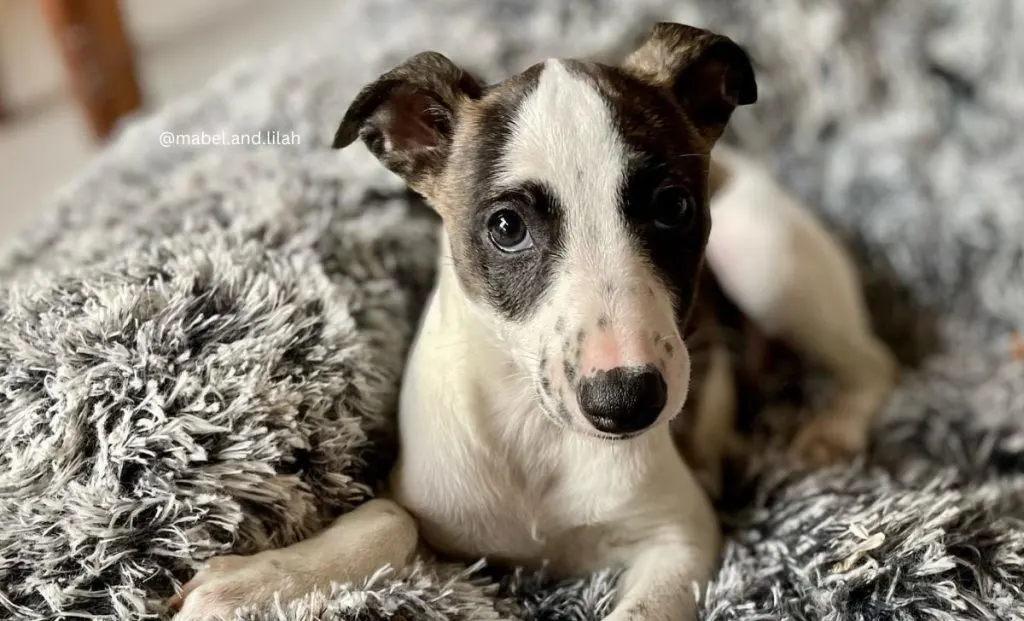
The black mask covers the muzzle and surrounds the Whippet’s eyes
The white markings are often found on the head, neck, chest, paws, and tail, providing a striking contrast.
6. Water Marked Whippets

Water marked Whippets exhibit a marbled or mottled effect in their coat. It often appears as if lightly splashed with a contrasting color.
This is a rare and intriguing pattern that adds a layer of depth and complexity to the Whippet’s appearance!
What Is The Rarest Colour Of Whippet?
The rarest color of Whippet is the true blue color, along with blue fawn and blue brindle variations.
Unlike more common variations like blue brindle or blue fawn, a true blue Whippet has a uniform, solid blue-gray coat resulting from a dilution of the black pigment.
References
- Kowalewska, I. (2023). CHARACTERISTICS OF THE MC1R GENE AS A LOCUS E AFFECTING COAT COLOR IN DOGS. Folia Pomeranae Universitatis Technologiae Stetinensis Agricultura, Alimentaria, Piscaria et Zootechnica. https://doi.org/10.21005/aapz2023.68.4.3.
- Strain, G. (2011). White noise: pigment-associated deafness.. Veterinary journal, 188 3, 247-9 . https://doi.org/10.1016/j.tvjl.2010.08.015.
- Slavney, A., Kawakami, T., Jensen, M., Nelson, T., Sams, A., & Boyko, A. (2021). Five genetic variants explain over 70% of hair coat pheomelanin intensity variation in purebred and mixed breed domestic dogs. PLoS ONE, 16. https://doi.org/10.1371/journal.pone.0250579.

Meet Iram, a devoted veterinarian, passionate dog lover, and current Ph.D. candidate at Utrecht University in the Netherlands. Seamlessly blending her roles as a vet and content writer, Iram channels her love for dogs into heartfelt narratives.
Since childhood, Iram nurtured a dream of becoming a vet, a passion that runs deep in her family. Having now fulfilled that dream, she’s eager to share her acquired knowledge. In her writing, Iram not only explores the emotional bond between humans and their canine friends but also integrates her veterinary expertise, offering readers a holistic understanding of their beloved pets.
